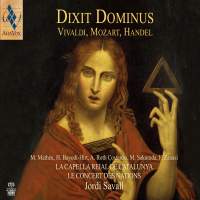Texte paru dans: / Appeared in: |
|
|
Outil de traduction ~ (Très approximatif) |
|
|
Reviewer: Bertil
van Boer
Psalm 110 (or according to
some translations, Psalm 109), the Dixit Dominus has been a favorite of
composers. As an overall text, it covers a wide variety of moods and
imagery, and within itself contains subdivisions, such as the Tecum
principium, that offer opportunities for separate smaller sacred works.
Almost every composer of the late Baroque and Classical periods set either
the complete text or portions. Here one has a performance of three of the
major figures, beginning with Vivaldi’s large multi-movement work (RV 595)
from 1717. It was presumably written for one of the larger churches in
Venice, since his day job at the Ospedale della Pietà would normally have
meant women’s voices only (though they could have easily adapted the
four-part chorus and bass solo parts). The use of a pair of trumpets allows
for the opening homophonic chorus to be quite festive, followed by the Donec
ponam with its restless dotted string accompaniment. Vivaldian rhythmic
structures also support the several solo arias, beginning with the jaunty
Virgam virtutis, where the virtue apparently lies in the perky and quite
florid soprano part. The Tecum principium duet for duo sopranos accompanied
by lower strings is rich from a textural standpoint, with the higher pitched
voices (reminiscent of the Laudamus te from the famed Gloria) providing a
registral contrast. The aria Dominus a dextris tuis begins with some solo
trumpet fanfares with the same march-like dotted rhythms, before the voice
and trumpet engage in a question-answer that expands into a fluid coloratura
line. With the words describing the Day of Wrath, the chorus enters
accompanied by some furious string tremolos; Vivaldi uses them in unison
with considerable effect. In the De torrente there is a hint of the tone
painting used in the softer parts of the Seasons, where the flowing of the
brook is represented by long melismas above an insistent ostinato. At the
end, of course, is the doxology, here in three parts, a trio and two
choruses. The last is a fugue that really seems more like canonic imitation
than a real bit of complex counterpoint, and in the end the musical edifice
congeals into a homophonic close.
The Vivaldi Dixit makes a nice
contrast with the other main feature of the disc, Handel’s large-scale
setting (HWV 232) composed early in his career in 1707, a decade before
Vivaldi. The opening chorus, with its odd interpolations in the minor key at
emphatic points, is like a perpetual motion machine, with the running
strings cycling through sequences without cease. The cries of “Dixit” are
like pointed announcements, though there is a nice set of suspensions that
thicken the texture in almost cantus firmus fashion. The Virgo virtutis is a
nice continuo aria of the sort that hints at Alessandro Scarlatti, with the
bass line walking in a steady pace matched by the alto. In the chorus
Juravit Dominus the solemn introductory chords of each short section unravel
into a more contrapuntal choral section that is reminiscent of Handel’s
famed oratorio writing. This is followed by a rather gnarly fugue, and the
Dominus a dextris in turn becomes a Corellian movement, with a running bass
above which the voices soar with broad suspensions. One can hear the
marching of an implacable army in the pointed lines of the Conquassabit
capita, while in the De torrente a slowly unfolding string ostinato with
some rather close harmonies and vocal suspensions paints a picture of
mystery rather than a flowing river. It is more like the current of
something broad and calm rather than swift and turgid. Handel’s fugal close
is more complex than Vivaldi’s. Both of these composers were to set the same text no fewer than three times, but each of those settings is too long to pair with these first examples. Besides, if one was chosen, the idea of musical contrast would tend to favor one or the other. Therefore, Jordi Savall chose a shorter companion to separate the two performances, Mozart’s early Dixit et Magnificat (K 193). This is set for a festive orchestra of strings and trumpets for Salzburg in 1774. Normally, he would have included this a part of a Vesper setting, in which it does belong generally as a single movement, and it is not beyond the realm of possibility that that was precisely what he intended, especially since he also paired it with the final movement of the Vespers, the Magnificat. The possibility that the other movements such as the Laudate pueri are missing cannot be dismissed, but the surviving pair represents his normal church style of this early period. The choral portions are neatly homophonic for the most part, with the occasional excursion into a bit of counterpoint. The Et in saecula saeculorum fugue is especially well done, though brief. All of these pieces have been recorded before, so comparisons abound. But the program chosen by Savall works as a trilogy of pieces. Soprano Hanna Bayodi-Hirt is light, perhaps a bit too light in places where she sounds a bit thin, but her counterpart Marta Mathéu is more robust, and Anthony Constanzo has a nicely resonant countertenor. Makoto Sakurada is flexible in his renditions; bass Furio Zanasi blends well, especially in the trio Gloria Patri of the Vivaldi. I like Savall’s tempos, which move the works along but are sensitive to the often complex lines. As one might expect, the Concert des Nations is precisely in tune, and the chorus from Catalonia is as disciplined as a smoothly functioning machine. They are clear and precise, never muddy, so that the articulation of the text is never obscured. All in all, this is a fine disc and is recommended. | |
|
|
|
|
Cliquez l'un ou l'autre
bouton pour découvrir bien d'autres critiques de CD |
|




